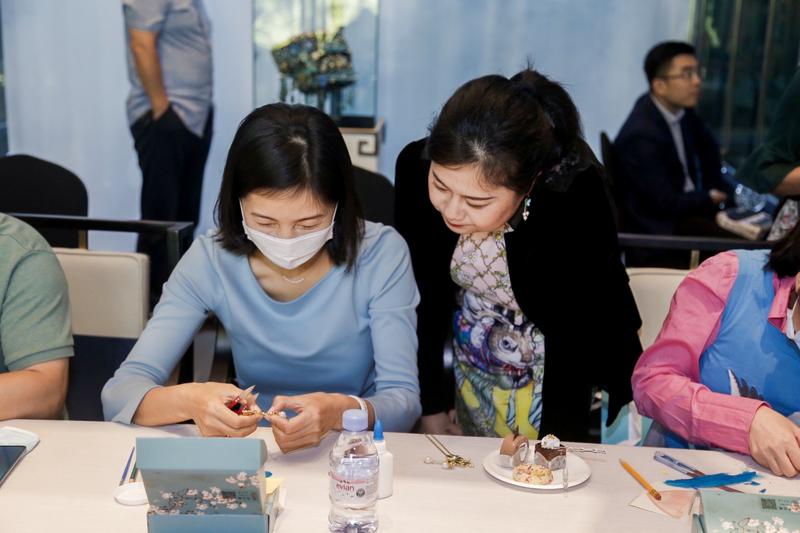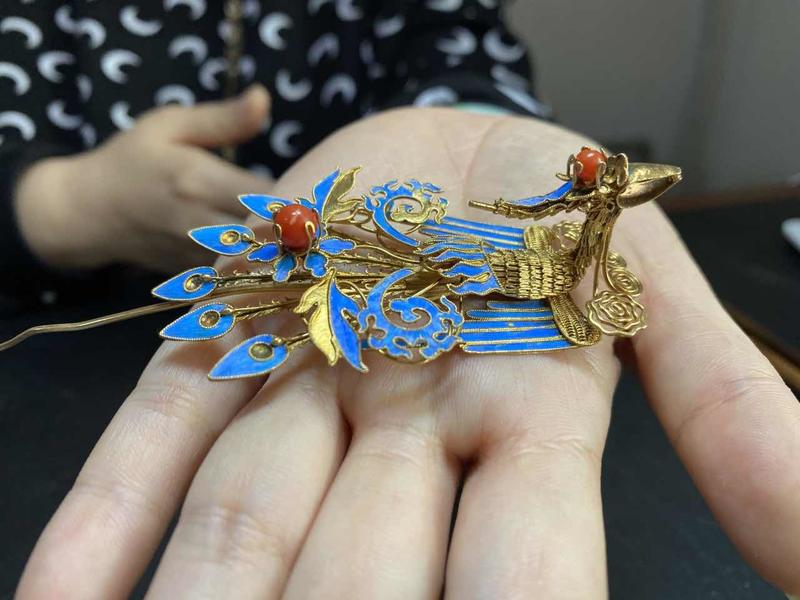Ancient craft of delicately decorating a metal base still intrigues but faces challenges of changing fashion, Xin Wen reports.
 Xiao Yumei guides a learner at a training class in a Beijing school. (PHOTO PROVIDED TO CHINA DAILY)
Xiao Yumei guides a learner at a training class in a Beijing school. (PHOTO PROVIDED TO CHINA DAILY)
Combining the heavy and the light in its technique, diancui (the dipping of blue) originated in ancient China. It requires craftsmanship, delicacy, a keen eye and patience.
The craft harks back to another era as kingfisher feathers are mounted in gold or gilt-metal surroundings.
The combination of metalwork and feather crafting to put the brightly colored feathers of kingfishers meticulously onto the surface of metallic accessories verges on the contradictory but it does work, often to stunning effect.
It became almost de rigueur in imperial palaces during the dynastic periods, when ladies of the court took pride in owning kingfisher feather decorations for hair accessories.
But the tradition-and the skill required to make them-has been fading and secrets of the craft risk being lost.
Xiao Yumei, a third-generation inheritor of diancui, has weathered some tough days since February, when modernity seems to have clashed with tradition.
That month, the white-throated kingfisher, one of the kingfisher types used for the craft, was added to the list of wildlife under special State protection.
 A head ornament made with the craft of diancui, but using goose feathers instead of kingfisher feathers. (PHOTO PROVIDED TO CHINA DAILY)
A head ornament made with the craft of diancui, but using goose feathers instead of kingfisher feathers. (PHOTO PROVIDED TO CHINA DAILY)
Xiao, who began studying the skill in 2014 from her father, Xiao Guangchun, an intangible cultural heritage inheritor for the art in Beijing, was in a bind.
"It's not a skill that can be mastered with adroitness in a short period of time," says Xiao Yumei.
"The arrangement, pasting and placing of the feathers require endless practice, sometimes involving hundreds of attempts."
At the same time, she says, aesthetically, the ornaments need be equivalent in appearance and texture to the original color of the bird's feathers.
"The countless matching of feathers, guaranteeing that they stay on the small parts of the golden accessories firmly and smoothly, requires peace of mind," says the 42-year-old.
The "dipping blue" craftsmanship of the Xiao family was once well-known in Beijing.
Her grandfather, Xiao Zhifeng, participated in the restoration of four phoenix coronets excavated from the Ding Tomb, one of the Ming Tombs in northern Beijing.
Her father, Xiao Guangchun, helped the art to get officially listed as a city-level intangible cultural heritage in Beijing in 2013.
 Xiao Yumei, an inheritor of the craft, creates a hair clasp at her home in Beijing. (PHOTO PROVIDED TO CHINA DAILY)
Xiao Yumei, an inheritor of the craft, creates a hair clasp at her home in Beijing. (PHOTO PROVIDED TO CHINA DAILY)
Xiao Yumei is the first female inheritor of the craft in her family, and it was not an easy start for her initially.
"I had a stable job and a constant salary before 2014," she says. "I felt fulfilled in that job-making artificial eyes for the disabled."
However, in 2014, as the eyesight of her father gradually deteriorated, finding an appropriate successor of the craft became an urgent mission for the family.
"Since I was little, I was told by my mother that practicing the skill is quite exhausting, and it places great demand on the artisan," she recalls.
"Previously, I was hesitant about whether to learn it or not, but my father's persistence and obsession finally touched me and prompted me to make up my mind to follow suit."
She quit her job and spent over a year, on and off, learning the exquisite craftsmanship. Apart from the knowledge required, her hands had to be as steady as a surgeon's.
Different kingfisher feathers have different colors. Before "dipping", the color of the base and the feather needs to be well matched.
In her view, eyes have to be particularly sensitive to the contrast of colors to distinguish the differences, which are often almost imperceptible.
The most time-consuming step, however, is the actual "dipping of blue".
 She displays the ready piece. (XIN WEN / CHINA DAILY)
She displays the ready piece. (XIN WEN / CHINA DAILY)
This is where the kingfisher feathers, after being cut into small pieces, are inlaid into the metal plate, Xiao Yumei explains, and the process is like embroidery as the tiny pieces of feather must be pasted subtly according to the edges of the decorative and lace-like filigree metal.
"Artisans precisely fit the feathers of a bright blue color into the surfaces of the metallic accessories. The accessories look very attractive when the feather pieces are fitted perfectly," she says.
Under beams of different light, colors of the feather vary, shining with every hue.
"The color of kingfisher is unique," says Xiao Yumei.
In ancient times, the color was considered a symbol of power and status, and was used by the royal family and nobility.
"They believed that hair accessories in the color could help them communicate directly with the gods, as the kingfisher was considered a swift messenger," she explains.
Conservation and wildlife protection concerns are having an impact. "I haven't done dipping much since the beginning of this year," says Xiao Yumei.
"Sometimes, I use goose feathers, which are dyed blue, to apply onto the golden plates."
Her husband, Liu Yingchun, says that she used to be engaged in the craft all day long but now she is writing a book to introduce the skill of diancui.
Xiao Yumei has also been to school campuses and exhibitions recently, in an effort to introduce the traditional handicraft to more people.
"I hope that the craft can be passed on, and last forever, in whatever way, no matter the material," she says.
Contact the writer at xinwen@chinadaily.com.cn


